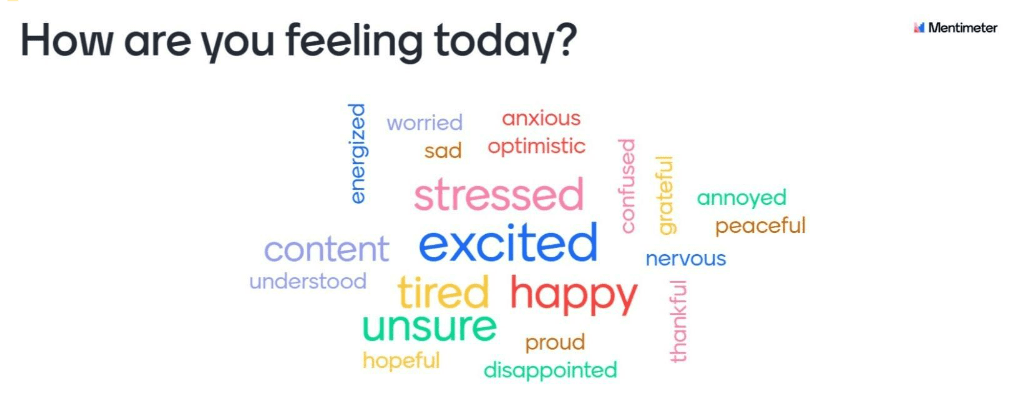Social Emotional Learning (SEL) can help build a positive class climate and support student well-being, so in this blog we give you five easy ideas to bring SEL into your classroom. Getting started with SEL may feel overwhelming at first but there are many things you can do to support your students in building their skills on the five SEL competencies. Below are some strategies to start incorporating social emotional learning in your classroom every day.
Have a Daily Check-In for Students to Share How They Are Feeling
Provide opportunities for students to share what emotions they are bringing into the classroom that day. This will help students identify their emotions and empathize with others, as well as help you build relationships within the classroom. An example of a daily check-in is to have students share how they are feeling using an emoji scale. Or, gauge the energy level of the whole class by creating a word cloud using Mentimeter. A third SEL check-in idea is both individual and anonymous – have students check-in by responding individually in your learning management system, which has the added benefit of making you more aware of each student’s needs. Check out this thoughtful article from Edutopia on Building a Better Check-In for ways to make your check-ins even more impactful.

Create a Common Language and Class Norms
Developing a common language and class norms helps students find the words to describe how they are feeling, navigate potential conflicts or disagreements, and hold themselves and their peers accountable for their actions. To create norms that are representative of your class, have students first create their own norms individually or in small groups. Then, as a class, facilitate a discussion where all individuals or groups share the rationale of why that norm is important to them. Here is a lesson plan from the Greater Good in Education to get you started with having your students create their class norms.
Provide Opportunities for Cooperative Learning
Cooperative learning requires skills from many of the SEL competencies, but especially for self and social awareness skills. Working in groups helps students build relationships, make responsible decisions, consider other perspectives, and practice communicating their ideas. Reviewing your common language and class norms before engaging in cooperative learning activities helps set the stage for collaboration and productive conversations. Some examples of cooperative learning strategies are problem-based learning, small group discussions, and simulations. Check out some of Population Education’s lesson plans that include these strategies and more for every grade band!
Make Dedicated Classroom Time for Student Reflection
Providing time for reflection helps students not only make sense of what they learned each day but also gives them time to develop self-awareness and build character. This comprehensive reflection tool from CASEL includes prompts for supporting student reflection for each of the five SEL competencies. There are many different ways you can facilitate meaningful reflection – students could reflect individually in a journal, share their reflection with a partner, or practice sharing their reflection with the whole class. It helps to give students a structure for reflection, like having a focused question, setting time for listening and talking during a peer-to-peer reflection, and having sentence starters for whole class discussions. Mix up the type of activities you do to keep students engaged in reflective practices throughout the year.
Partner with Families and the Community
Teachers are often at the heart of social emotional learning. But in order to fully develop students’ SEL skills, they need support outside of the classroom as well. Partnering with families, other colleagues within your school, and the local community can help build a network of support for your students. The settings within CASEL’s SEL framework show how the school as a whole, families, caregivers, and the entire community can contribute by developing school-wide practices, providing opportunities for authentic partnerships, and extending learning opportunities into the local community.
Add SEL to Your Classroom Now!
Incorporating social emotional learning in your classroom gives students opportunities to develop their interests, set goals, consider the perspectives of others, build relationships with their peers, and so much more. Which of these SEL activities are you most excited to try?
*Word cloud created using Mentimeter.




